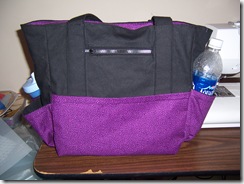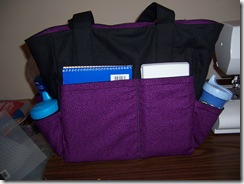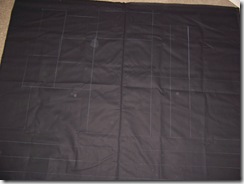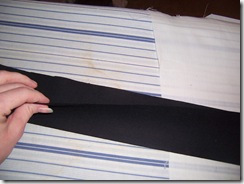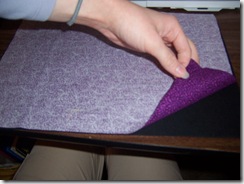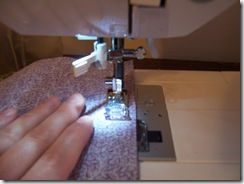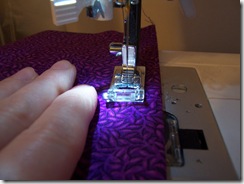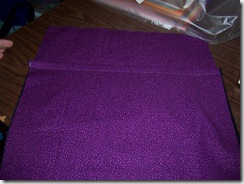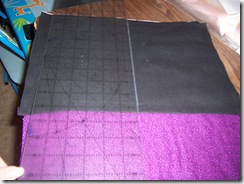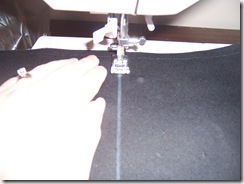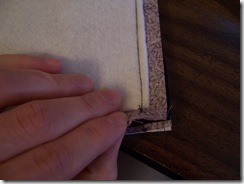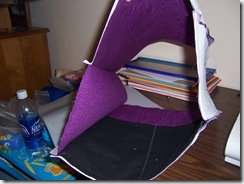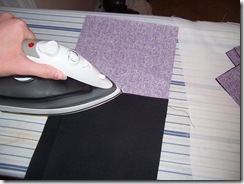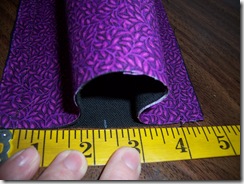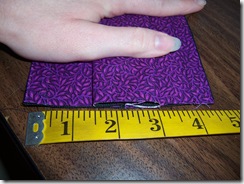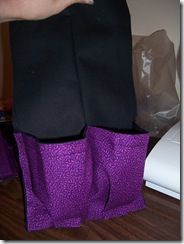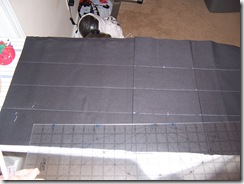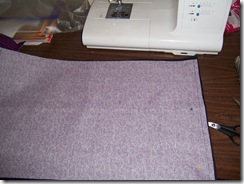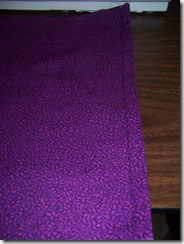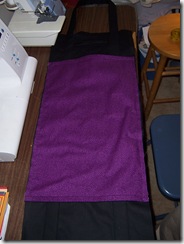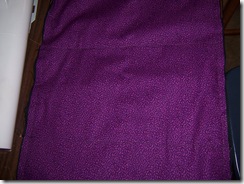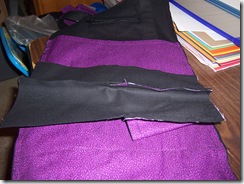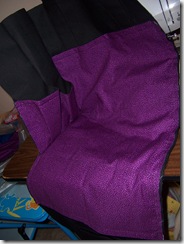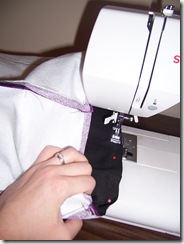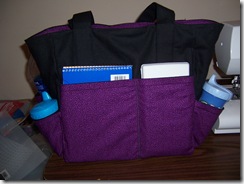Materials Needed:
1 yard 54" fabric (decorator, canvas, something strong) - for the outside
1 yard 44" or 54" fabric (for lining)
13" fusible fleece (for front, back, and sides - if you like) (add another 7" to do the bottom too)
plastic canvas (at least 13x7")
thread to match (1 spool)
Directions:
Cut out the pieces according to the diagrams below. If you use fusible fleece, cut out pieces 1" narrower and shorter than the sides, front, and back of lining.
If you use something that's too hard to cut with a rotary blade (like canvas), use tailor's chalk (the lines aren't as obvious in the picture as in real life).
Cut out all the pieces according to the diagrams below:
If using fusible fleece (as here) or fusible interfacing, fuse all pieces to the back of the outer bag (or in my case, the inner bag) pieces. (The textured side of the fusible stuff should face the wrong side of the fabric!) I chose to fuse it to the lining fabric since the bag fabric was canvas...already sturdy enough!
For the handle, I fold the handle piece in half lengthwise (iron to crease), unfold and fold in long edges to this crease. Then fold in half (so that new creased edges come together).
Note: for canvas, this is extremely challenging to sew through. If done over, I may have used the other fabric for the handles (putting a layer of batting down the center for shoulder comfort).
Iron to crease. (Baste if you like; I'm too lazy).
Another favorite handle variation is to fold the two long edges toward and past the center so that it is creased into thirds (lengthwise), then cover the middle (where one raw edge is) with a ribbon. (Topstitch down the long edges of the ribbon.) Batting or fusible fleece down this version also makes it much more comfortable.)
Prepare the (inside) back divided pocket:
For the large divided pocket, place fabric/lining right sides together and sew (1/2" seam allowance) at top edge.
Turn right sides out, and topstitch 5/8" away from seamed edge (it looks nice).
Align pocket on (inside) back piece with bottom & side raw edges even. Baste around the edges.
You can have the pocket the same with contrast on the inside or contrasting with the main fabric as the pocket lining.
I chose the pocket to be contrasting fabric facing out.
Measure and mark a line to divide the pocket into two pockets (half the width each). Draw this line, and top stitch from the bottom to the top with a wide stitch (decorative or zigzag...with a few extra 'zags' near the top to secure).
Sew a side and this back prepped piece together (right sides together, aligning raw edges, 1/2" seams).
note: leave the seam allowance (1/2") at the bottom unsewn...it will make putting the bottom on the bag much easier!
Repeat for other side and bag lining front piece. Should look like a tunnel!
Matching corners, sew bottom into lining (check to make sure the pockets are going the right way before you do this!)
The lining is complete...on to the OUTSIDE of the bag.
OUTER SIDES
The open pockets (yes, all 5 of them)
Start the same as for inside divided pocket (right sides together, 1/2" seam allowance and after flipping right side out, 5/8" topstitching from seamed edge). Use your iron...it will make it easier.
There are 4 narrow side pieces for the outer bag. I will call these "half-sides".
Align one pocket at bottom and side edge of half-side. Baste (1/2" or closer to edge).
Align other edge of pocket to other side edge of half-side and again baste (leaving "extra" width out of the way).
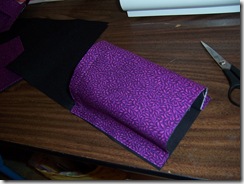
Measure and mark the 1/2-way mark at bottom edge of half-side.
Flatten pocket, forming a pleat (or several pleats or gathers). I center the pocket on the mark and make a symmetrical pleat, but you can make it however it looks nice and is easy to do.
Each half-side should look like this (my bag has varying pocket heights because I designed it for 4 different water bottles/cups), but the general look will be the same.
So, repeat this 3 more times! (It's easiest to do some parts 'assembly line style' - prep all the pockets together, iron them all together, and then sew them on all together - rather than doing the whole process start to finish for each.)
Now that all of your half-sides are done, pair them up and sew two half-sides (right sides together) with a 1/2" seam allowance (watch out not to catch any of the pocket in the seam).
BAG FRONT/BACK
With right sides together (and 1/2" seam allowance...do I really need to keep repeating that?), sew bag front to bag bottom along long edge. Also, sew bat bottom to bag back. Watch what you're doing, or you'll end up with seams going in opposite directions like I did (I have never made it through a project without having to pull out the seam ripper!)

Now, measure and prep this for the pocket!
Measure and mark 3" in from each side along these bottom seams.Then, mark the halfway point on each of these lines. This halfway mark will be where the handles begin and end on the bag bottom.
Continue the lines (that are 3" in from the edges) up the entire back back/front - this is to keep the handles straight.
Pin the handles on (starting and stopping at the marks on the bottom of the bag). Each handle should go up and down the front or back (not both). See picture.
Sew along the edges of the handle (stopping about 1" from top of bag).
(If you're sewing a 4-layer canvas handle onto a canvas bag, I wish you good luck and I hope you have a very strong needle!) If the handles didn't frustrate you enough, zigzag along where the handles meet at the bag bottom.
Now, add the zipper pocket.
(I found directions online for a zipper pocket, so I won't repeat the how-to for this part; just the measurements I used.)
The line is 5" wide, centered between the handles.I forgot to write down how far from the top of the bag it was, but this sewing gauge is 6", so I think it was 3 1/2" or 4" from the top.
On the pocket, the 1/4" rectangle is centered around a 5" wide line that is drawn 1" below the center of pocket (found by folding long pocket piece in half shortways). The pocket is made by folding this pocket piece in half after all the sewing, cutting, and turning, but it's a little tricky to get it right so that both halves of the pocket fold to the meet at the bottom. A good idea - just make the pocket longer than you need and trim off to make the edges even.
(The pocket is too aggravating to explain, so if you don't get it, just click on the link for the wonderful directions I used to learn it! And if it still sounds too hard, just skip the zipper pocket altogether!)
-----------------
Now the large outer pocket that spans the front/bottom/back of the bag.
Like all other pockets, begin with right sides together. For this pocket, seam top AND bottom with 1/2" seam allowance.
Turn right sides out and iron. (Topstitch 5/8" from seamed edges.)
Place the outer pocket on top of the outer bag (right sides facing up). Baste along the long raw edges.
Turn the bag front/bottom/back so that you can see the wrong side. Sew along the seams where the back and front meet the bottom of the bag.
Starting at the seam dividing the bottom and back of the bag, top stitch to divide the pocket into two pockets. (I put in a notepad and wipes case and marked where the division should be.)
Add the sides!
Align the bottom of the side with the short (raw) edge of the bottom. (This is the side of the bag between the two seams you just made.) Sew with 1/2" seam allowance (leaving 1/2" at bottom of side open).
Align the long raw edges of the side piece with the side of the bag front (this is involves a little twisting and adjusting since the bottom and front are already sewn together). Sew with 1/2" seam. (See pic.)
Repeat for back (the part currently hanging off the table). Then, repeat for other side.
(This can be a little trickier than sewing front, back, and sides together, and then adding the bottom....
but, this allows for the 'gusset' pocket that covers where the handles meet while still having sides that are separate pieces with pockets.)

Sew on the plastic canvas to the bag (outside or inside, whichever is easier) by sewing through the four corners.

This will end up between the layers.
Another option, is to simple make a 'pocket' for the plastic canvas (cut to the dimensions of the bag bottom after seams) and sew it shut after inserting the canvas into it. This separate pocket can be placed inside the bag to fill the bottom, and then removed to make the bag washable and dryable (that is, depending on your choice of fabric).
Place the bag inside the lining with right sides together (or the lining inside the bag...as long as right sides are together!) Make sure the handles are tucked down between the bag and lining and are not caught in the top 1/2" of the bag. Pin around the entire top - matching corners.
Sew - 1/2" seam, leaving an opening somewhere big enough to get the plastic canvas through (for me, that's about 7-8" since that's the narrowest side of the canvas.
Turn it right side out (so that it looks like the bag that it should be!) and top stitch around bag top, closing the hole you left for turning. (I like to turn in my edges of the hole and sew that shut first.)
Sew along the top of the handles for a little more support at the bag top.
VOILA! A cute and very sturdy bag. All the pockets were sized to fit the water bottles and sippy cups that I use (and note pad and wipes case, etc.) - you get the point.
(This one is for my sister in law Rachel...perhaps I should have asked her the sizes of her sippy cups, water bottle, and baby bottle!)
Alternative ideas:
For the bottle/cup pockets, you can insert elastic into the 'casing' made by sewing 5/8" from the seamed edge...I just hate trying to stuff in a cup with one hand into an elastic pocket while keeping my twins from jumping out the cart at Walmart, so I do "open" pockets that are pleated.
Oh, I added a cell phone pocket onto the bag last minute (like right before I sewed the outside to the lining! You can see it in the last picture. Cell phones are so many different sizes, that I guessed what would work for hers, and left it out of the directions, but you are free to add one in. (It's just an easy rectangle of fabric, lined, and then sewn onto the inner side of the lining.
If you decide to do anything with fusible interfacing, here are some cutting layouts to help:
